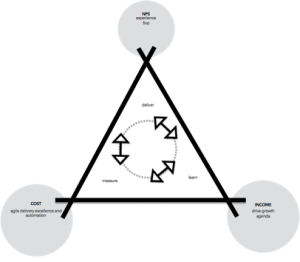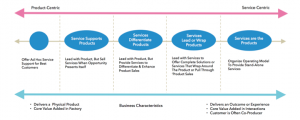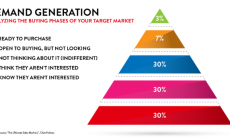In our days, design becomes the cornerstone of digital transformation projects. Regardless of the industry or the verticals companies or consultancies operated based on, (what does this mean exactly?), design takes its leading role not only in addressing client-facing problems but also in humanizing and simplifying complicated structures and technology infrastructures.
Human-centered innovation begins with developing an understanding of users’ unmet or unarticulated needs. “The most secure source of new ideas that have true competitive advantage, and hence, higher margins, is customers’ unarticulated needs,” says Jeanne Liedtka. “Customer intimacy—a deep knowledge of customers and their problems—helps to uncover those needs.” (Batten Briefings 2015).
Design thinking minimizes the uncertainty and risk of innovation by engaging customers or users through a series of prototypes to test and refine concepts. Design thinkers rely on customer insights gained from real-world experiments, not just historical data or market research. But the value of a design thinking approach lies on the fact that a design thinking approach requires all the involved parties (clients and agencies, customers and brands) to work together, refine the outcome collaboratively, and drive the output in coordination with what the management wants to achieve and deliver.
People say that you can’t heal or solve something with the same cause of the problem; the infection or the challenge we face. Design gives us this opportunity: to shift the perspective from a something really tight, really based inside-in approach to one led by Insiders coming from the outside world. In addition to this, we are privileged to live in a world or experience a context that creates daily terabytes of data. This allows us to completely change the way we create the new digital business model in order for an organisation to deliver value. We use data the same way sailors use the radar, to show us what is ahead and understand the “weather conditions,” while design works as the compass to where we want to go and the direction we want to pick for the services and products an organisation has in its portfolio.
Design-based work is capable of delivering value to the most complicated cases. Great design has that “wow” factor that makes products more desirable and services more appealing to users regardless of whether we are talking for everyday consumers or company stakeholders who architect how a modern IT infrastructure has to be set to serve a multi-context, cross-functional business system. Therefore, business strategies not only have to create a feasible approach to digitize an organisation but also how this organization will transform from a features-provider to an ecosystem enabler. Moreover, it allows us to work in three different contexts when we transform an organisation:
- To enhance and optimise the way the organisation operates today
- To design and deliver new digital design-led, context-driven, human-centric, business models
- To digitize technology while we address how to drive innovation even further
Due to the remarkable success rate of design-led companies such as WeTransfer, Airbnb and Pinterest and many others, design has evolved beyond making objects or services. Organizations now want to learn how to think like designers and apply design principles to the workplace itself. Design thinking is at the core of effective strategy development and organizational change. It drives the way organisations learn from what others have achieved in other sectors, how they drive their teams to explore new boundaries and of course, how the new knowledge can be applied to their cases.
“Design-thinking firms stand apart in their willingness to engage in the task of continuously redesigning their business…to create advances in both innovation and efficiency—the combination that produces the most powerful competitive edge.”
—Roger Martin, author of the Design of Business
It is remarkable to notice how the design-led approach makes organizations more confident to try new things, new products and services while accelerating their ability and capacity to deliver value to their clients. In our team at Wipro Digital, we have managed to lead major organizations, which applied our well-executed design-led strategy to deliver new versions of products or services ten times faster than before while improving their ability to absorb feedback or findings from the previous ones. At the same time, a design approach drives the transformation or the Darwinian adaptation of an organisation from a product-focused value delivery to a service one.
Although there is so much design activity going on in the world, the ways in which people design were poorly understood for a rather long time. Design skill has been considered as something that perhaps many people possess to some degree, but only few people are exceptionally “gifted.” Today, a design-based and -led approach or a business design strategy is something based on data: understanding of the context and the ability to form and express what the challenge or the problem is. Having said that, we can claim that a design-based approach is not industry or vertical-led.
The value of the design-led strategy is to optimize or disrupt the industry by providing solutions to well-defined problems. The strategy relies on its openness and data-driven nature to deliver the human-centric service.











